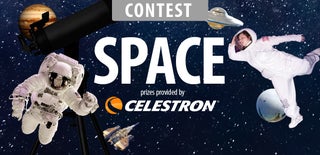Introduction: Webcam to Planetcam
Through this instructable and about 30 minutes of time we will modify a standard webcam to take photos and videos of most of the large bodies in our solar system. The idea here is that if we replace the webcams lens with say a much larger lens (i.e. telescope) then you can record and take images using that much larger lens. There are limitations as to what this setup can do and why I called it a planetcam. The main limitation is because of the very fast exposure time of a webcam (in the ms range) the imaging chip cant gather as much light as its would need to say image stars nebulas and galaxies so we are limited to the very very bright objects in our solar system. You may be unimpressed at first at the images that you get but its in post-processing where the image changes from a blurry pixilated image to a sharp detailed image so don't worry.
What you will need:
1: A webcam. This needs to be one where you can adjust the exposure and gain of the camera. Most name brand cameras can do this but I would check this before you get your warranty voiding kit and take it apart. On linux you can do this with v4l2-ctl --list-ctrls and if anyone has a nice way on OS X or Windows to do this please comment and I will add it.
2: Telescope. If you have one with a EQ mount and a motor drive even better but if you don't you can still do this but it will be more of a manual process of centering, record, recenter, record, ...
3: Small screwdrivers
4: Film canister, thin cardboard and tape, plastic tube or something along these lines that is 1.25 inches round or 2 inches round depending on your telescope focuser. For this I rolled up a thin piece of cardboard and used electrical tape to keep its shape.
5. A video capture software that allows you full control of the webcam settings. Windows I hear a lot of people using sharpcap and for us Linux/OS X people I like oaCapture.
Well let get it started shall we...
Step 1: Void the Warranty/Remove Lens
If your webcam passed the exposure/gain adjustment check let get it ready for the telescope. First remove all parts that are used for mounting it on your desk or what not as we don't need them and they will get in the way. Second remove the lens and focuser and get to where we have just the bare CCD or CMOS chip exposed. This camera I am using has a CCD but most of the ones you will find the the stores today have CMOS. Years ago I would have said that CMOS wont work and you need to find a CCD but today its almost the same for the output image and I have used both types of sensors.
Important bit here is that we DO NOT TOUCH the sensor at all. Actually what I do here is once the focuser and lens is removed I put it immediately into a plastic bag.
Step 2: Attach Tube to the Camera
This is really simple here. Place tube onto the camera centering it as best as you can so the the sensor is centered in the tube and tape or attach it so that no light can get in from the sides.
Step 3: Pro-Tips
1: You may need to adjust the length of the tube to fit into a barlow lens but don't make it too short that it becomes unstable in the focuser of the telescope.
2: If you are having trouble focusing the webcam attached to the telescope you may need to move the camera sensor closer to the telescope focuser. Lots of ways to do this but when I did this to a Microsoft Livecam I had to remove the camera from its factory housing and make my own slimmer housing but its not hard and will depend on your camera that you started with. I did not have to do this with this logitech.
3: Focus and centering this in your eyepiece is key to finding it with the webcam. Typically the webcams view is about what a 6mm or a 4mm eyepiece would show so you need to nicely centered before you drop your camera in or you will be there all night trying to get the planet or moon on the screen.
Step 4: Post Processing
This is where the art comes in. I thought about doing a little guide here about stacking and processing the videos to images but decided against it. My reason for this is its better to see than read about something like this and there are some great youtube videos from people that are much better at this than I am. So in an effort not to reinvent the wheel here are some links to some really nice wheels.
I use both Registax 6 and Autostakkert2 for most of what I do:
Links to software in this instructable (All free or open source. Man some people sure are nice):
Registax 6: http://www.astronomie.be/registax/
Autostakkert2: http://www.autostakkert.com/
SharpCap: http://www.sharpcap.co.uk/
oaCapture: http://www.openastroproject.org/oacapture/

Participated in the
Summer Fun Contest 2016

Participated in the
Space Contest 2016

Participated in the
Outside Contest 2016













